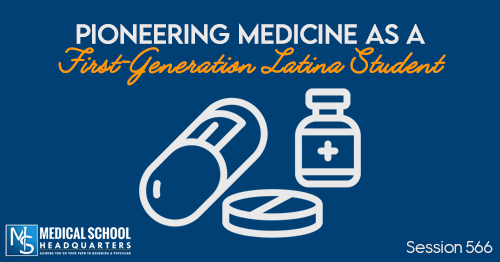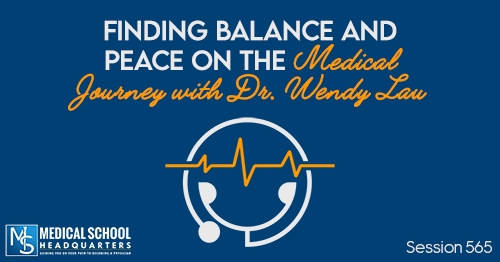Apple Podcasts | Google Podcasts
Session 89

In today’s episode, Ryan and Allison talk about choosing a medical school, the thought processes behind why they chose the schools they applied to, and things you need to consider as you’re going through the process of figuring out where to go to.
Many medical schools across the United States are excellent, and the current average number of medical schools that people apply to is 15. It really doesn’t matter how many schools you get into, as long as you get into one. It all boils down into choosing a medical school that best fits you, your preferences, your personality, and your needs.
It all boils down into choosing a medical school that best fits you, your preferences, your personality, and your needs.Click To TweetHere is a guide to help you narrow down your choices of medical schools to apply to:
State schools vs. Out-of-State
- State schools supply seats for state residents with rules and percentages of seats that go to state residents.
- If you’re an out-of-state resident applying to a state school, you generally need to have a very high MCAT score or 4.0 GPA, you need to know somebody who knows somebody, or you need to explain why you’re going to stay in that state and practice medicine.
- Most private schools do not any give preferential treatment to in-state applicants.
[Related episode: Should I Apply to an Out-of-State Medical School?]
Residency affiliations and nearby hospitals
Go to medical school with an open mind.
If you’re leaning toward a particular specialty, look for schools that have affiliations with a residency program. This will make it easier for you to get exposed to the people within that hospital and start building relationships.
Know the number of hospitals within the area and which hospital affiliations the medical school has.
Why determining residency affiliations is important:
- Allows you to get a taste of the patient demographics. Notice the disparity of health care between the affluent and low-income patients.
- Gives you an idea as to where you may end up living and where you’ll be doing your clinical rotations.
MD vs. DO medical schools
DO schools may not be affiliated with large academic teaching hospitals as often, so make sure to see what is around that school for opportunities to do rotations or research or work with people in your vicinity.
Our advice: Treat MD and DO schools the same. Don’t look at them any differently. In the end, you will be treating patients and practicing medicine in either. MDs can treat holistically and DOs prescribe medications. So the way they practice medicine is the same.
Whether you go MD or DO, you'll be treating patients and practicing medicine just the same.Click To Tweet[Related post: MD vs DO: What Are the Differences (And Similarities)?]
Are DO schools inferior to MD schools?
There is a misconception that DO schools are inferior to MD schools, possibly because of grade replacement at DO schools (which is no longer a thing!). In the past, DO schools allowed for grade replacement on your application, so if you took Calculus and got a C, then took it again and got an A, the DO application would only credit your new score. MD applications would average the two and give you a B.
Don’t think that just because your grades aren’t “good enough” for MD schools, then you should apply to a DO school. In fact, statistics suggest that it’s harder to get into a DO school.
[Related episode: 6 Myths of Osteopathic Medical School]
Weather
Be aware of the weather conditions, especially if you have a preference for certain climates (warm or cold).
Also, be careful about going to a place that’s constantly nice outside, where you’ll have the urge to go out to the beach every day. Go somewhere you can be happy but also where you can focus.
Proximity to family and friends
Consider whether you want to be near your family/relatives or you want to get away from them. Some people prefer to be near their family so they can get support whenever they need it, while some prefer otherwise.
Some medical students attend school near their family so they can get support whenever they need it, while some prefer otherwise.Click To TweetGPA and MCAT
You are a lot more than your numbers! When you’re going through the MSAR or CIB, the lists of MD and DO schools with their statistics on average matriculants—remember what you’re seeing there is just statistics.
If your GPA or MCAT score is lower than the average for a school, that doesn’t mean you can’t get into that school. That is just the average. So about half the students are above that, and half are below that. So don’t the let the numbers discourage you.
Instead, go visits the schools. Look at the environment and the state it’s in. Look at the hospital affiliations, the kind of research going on at the school, and the class size. The MCAT and GPA statistics for a school should not be the deciding factor for whether or not you apply.
The MCAT and GPA statistics for a school should not be the deciding factor for whether or not you apply.Click To TweetWant more discussion on this same exact topic? Check out Session 304 of The Premed Years: “How to Choose a Medical School & Put Together a School List.”
Links and Other Resources:
- USA Today article: “Poor people with diabetes more likely to lose a limb“
- MSAR (for MD schools) / CIB (for DO schools)
- Related episode: The Journey to a Caribbean Medical School
- Related episode: What are My Chances of Getting into Med School?
- Need MCAT Prep? Save on tutoring, classes, and full-length practice tests by using promo code “MSHQ” for 10% off Next Step full-length practice tests or “MSHQTOC” for $50 off MCAT tutoring or the Next Step MCAT Course at Blueprint MCAT (formerly Next Step Test Prep)!











